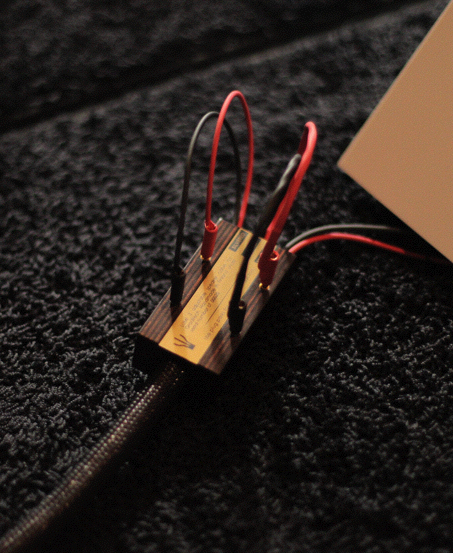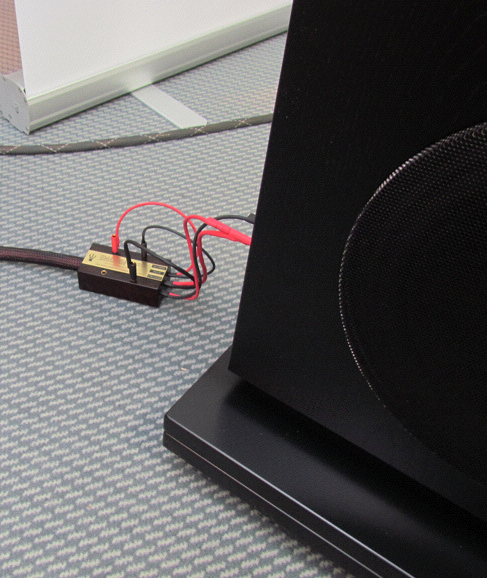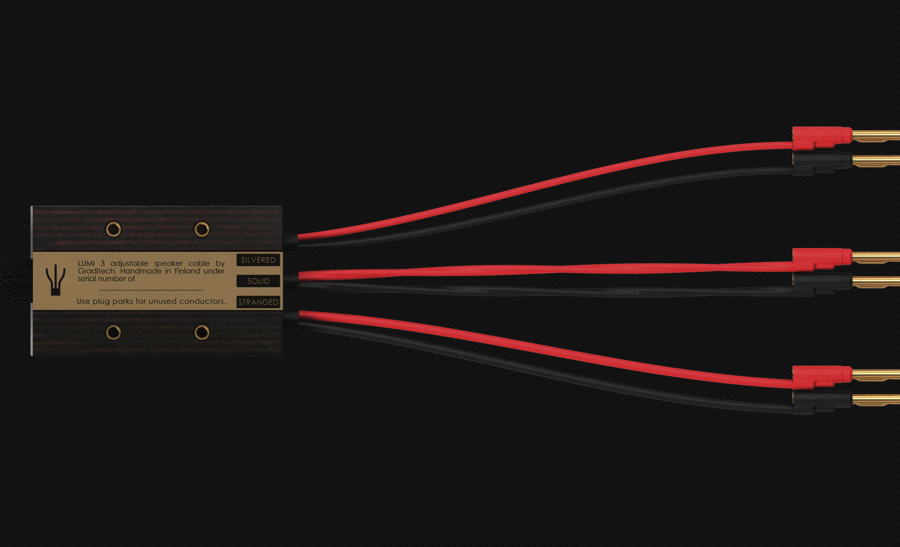Here’s how I act when I receive a new audio cable for a review: if the change in the sound isn’t immediate and somehow “obvious” to my ears, I don’t bother to go on and persuade myself to hear things, which I didn’t hear in the first place, at the same time not denying the possibility of the difference.
On the other hand, if the change is there, with no need to convince me or anybody else of its appearance, I’m more than happy to proceed with further investigations. It doesn’t matter if the nature of the change seems a little obscure, as long as there’s no need to see it in an excessively favorable light.
For this crucial Step One test, I connected Graditech’s Lumi 3 speaker cable to A+Audio’s Voxativ-based widebandwidth loudspeakers, hugely revelatory speakers especially in the midrange.
It took a few seconds to “realize”, “perceive”, “observe”, “experience” that there was a “difference”. Something changed. I don’t know what would be the correct verb to accurately describe the underlying mental process. Something inside me, a movement of the “soul” assured my head about the idea of the change. That’s it. The magnitude of the difference was such that I felt it would’ve been utterly foolish to deny it. And I’m not easily persuaded.
The question about the cause
Before moving to the question what was different, let’s give a thought to the possible natural cause for the difference. When it comes to audio cables, my personal view is that we have to accept a piece of mysticism here. Mysticism means uncertainty of the source. And that’s what we have for the moment: no one knows or seems to know exactly what inside the cables causes the sort of sonic differences between cables that many enthusiasts claim there to be. A proof? If there were a full knowledge of the issue, and I mean “full”, we would have only cable, or at least only one type of cable. And that is not the present situation. That’s why my worldview prevents me from presenting too bold statements about the topic. There are countless hypotheses, of course.
So I think that by definition, there’s no “exact” science behind the Graditech Lumi 3 speaker cable either. But they do suggest something tempting in this regard. The design philosophy of the father of the cable, Pasi Lankinen, gets under way from diversity of conditions under which speaker cables have to work in between various amplifiers and loudspeakers.
For Lankinen it is almost self-evident that a speaker cable, independently of the type or brand, that “works well” in one amp /loudspeaker combo may fare poorly between another amp and loudspeaker. That may not sound as a big deal – that’s what hobbyists keep telling us all the time – but that’s what cable markets currently intimate: manufacturers offer their cables as a cure for practically every problem and for every system, the underlying assumption being that one and the same cable will produce optimal results from a system to a system.
Pasi Lankinen thinks contrariwise: no one cable can produce the best sound in every system, and therefore, the better the speaker cable eliminates system dependency, the better it is. And that’s exactly what his speaker cables are supposed to do: eliminate system dependency.
So what’s so different about amps and loudspeakers that each combination requires special care? What are those differences that have to be eliminated? Lankinen prefers not to be too specific about this issue (for him the general truth that systems differ is more important), but for the sake of an argument, let’s have a look at a possibility (discussed in the forum of Finnish hi-fi hobbyists) in order to see what might be going on here.
The idea is that cables as such do not produce any sonic differences, but together with certain electric properties of amplifiers (output stage) and loudspeakers, can do so – in particular when the amplifier’s output impedance is made very low by using abundant amounts of negative feedback.
According to this theory, audible problems may occur when the rise time of the amplifier and the time constant L/R (inductance/ resistance) of the speaker cable are not perfectly matched in order to obtain an acceptable impulse response. If the resistance R is made every low, the higher is the time constant, and inductivity of the speaker cable becomes evident already at lower frequencies. When the speaker cable’s time constant (L/R) is too large in relation to the rise time of the amp, the cable distorts the signal at all high-speed voltage level changes due to severe cable oscillation.
Luckily there’s an easy cure for this. If the amplifier is a very low impedance amp, it is possible to obtain an undistorted signal by reducing the cable’s time constant by increasing its resistance. This can be done eg. by using an external resistor. Relevant to our case is, however, that the L/R-ratio can, in principle, be affected by combining wires of different kind (copper, silver, stranded etc.) precisely as what happens in the Graditech Lumi 3 speaker cable. (image courtesy Jens König)
Make no mistake here: Graditech is not appealing to rise times or time constants as the possible cause for sonic differences between cables. But they do speak strongly for the idea that amplifiers and speakers behave differently with different cables, and that there’s only one ideal speaker cable setting (wire combination) for each system to sound its best. (As there is only one L/R-ratio that ideally matches with the amp’s rise time.)
Since the amp and the loudspeaker can be treated here as exogenous variables, so to speak, it is the speaker cable that has to be the endogenous variable. The speaker cable must be adjustable, asserts Lankinen, which is why his Graditech speaker cables are extremely flexible! Lumi 3 is the most versatile speaker cable in this regard that I’ve encountered in my reviewing career!

Lumi 3 Speaker Cable
So here we are: Graditech Lumi 3 is an adjustable speaker cable that thanks to its proprietary ALC™ technology offers a “new approach to getting the best sound out of a system with just one cable”. How does it do it?
It does it by not being just one cable, but three cables in one. Each Lumi 3 consists of three pairs of wires (three different matched conductors): single-threaded copper (Solid Core), stranded copper (Stranded) and Teflon-insulated silver-plated copper (Silvered). The company tells us that dozens of connectors and dialectics were listened to and carefully selected to arrive at this selection of wires.
Not only the material of the conductors varies, their cross-sectional area varies too as well as their geometry. Raw materials were hand picked and tested, says the manufacturer. The copper comes from a Nordic country, and is claimed to be the purest copper in the world.
The wires are joined together at one end of the cable, and divided into three pairs at the other end. The wooden boxes at both ends of the cable are practical devices only; there’s no active or passive signal manipulating techniques inside them. The first box collects all three wires together for a more secure connection to the connector. The second box is a parking house (LUMI Cable Park™) for unused cable ends at the same preventing the unused cable ends from short-circuiting.

The use of a multi-wire cable
The three cables can be connected not only alternately, but in a row too, ie. one behind the other (the rear end of each banana plug is open). The ALC concept is simple: just select the combination of conductors that best connects with characteristics of your system and allows the music to flow. No matter what the equipment is, the cable always adapts.
If there is an inconvenience, it is the number of permutations this cable permits. The task is not just to switch between the Solid Core, Silvered or Stranded conductors. Adjusting can mean the Solid Core cable enhanced with the Silvered wires or the Stranded conductors intensified with the Solid Core. Or it can be all three together. Or it can be the Solid Core tuned with one lead of the Silvered conductors, and one lead of the Stranded. Or it can mean one lead of the Silvered cable (plus pole) and one lead of the Stranded cable (minus pole) etc. etc. etc. If the loudspeaker has two pairs of binding posts, then it gets really wild. The reader is cordially invited to figure out how many combinations (permutations) can be obtained with the six wires.
Even without any statistical calculation it’s evident that Graditech Lumi 3 provides numerous opportunities to manipulate the interplay of the amplifier and the loudspeaker. The principle is so clever, and makes such sense, that it’s strange that, as far as I know, it hasn’t been invented in the past!
Graditech urges its customers to be patient, and try different options. Very rarely, they say, connecting just one wire pair, whether Solid Core, Silvered or Stranded, would yield the best results. The same is true of coupling all three together. The most convenient approach is to provoke a gross change in the sound, and then if the sound changes too much in any direction, tune it by connecting or disconnecting wires one by one.
And note that one-sided coupling is not harmful; the only thing that matters is the sound. According to Graditech, it may even turn out that the most useful way to use the cable is to use it in a “wrong way”, ie. the three wire pairs at the amplifier end. You see, this will never end. Lumi 3 is a heaven for those who are obsessed with cable experiments! When the best combination is finally found, the bulb lights up and the face becomes just one big smile!

Sound difference
When I woke up to the “difference” for the first time, the cables before were Corfacs, later points of comparisons (always keeping the volume level normalized) included Gregiteks, and some other quality cables.
Curiously enough, due to the design idea of the Graditech Lumi 3, the role of reference cables is secondary in the story. The fact that the reference cables may “sound” stunning in one particular system is fully compatible with Graditech’s design philosophy, although they would never do so in every system. Hence, we need to be more interested in Lumi3’s internal sonic differences rather than differences between it and other cables.
My jumping-off choice or adjustment was to use Lumi 3’s Solid Core wires (single-threaded copper). Only them. It was with the Solid Cores that I first became aware of the difference, and they soon became my favorites, the mainland for further tests.
I did of course try the Silvered conductors and the Stranded ones, but always returned to the Solid Core option, partly because I felt that the effect (“that something”) that first stopped me, was weaker or less present with the two other cables.
Just for your curiosity, the reference cables, quickly conceived and approximately speaking, sounded dynamically as Lumi 3’s all three conductor pairs combined together, and tonally as the Solid Cores and Silvered wires fixed together. But as said, the reference cables aren’t the issue here.
The Solid Core wires as my stronghold I started to make subtler explorations in order to see if I could “hear” tonal shifts or other nuances, and of course, to discover the ideal combination of wires for this particular setup (Knif Audio Class A solid state amps & A+Audio Voxativ speakers).
I added the Silvered conductors to the Solid Cores then unplugged the Silvered wires and connected the Stranded wires instead, then tried all three wires together, and then disconnected the cables one by one until I again had just the Solid Cores. And this several times in different order.
In the end of the day I ended up making tests in which I tried to understand what happens to the Solid Core “sound” with and without the contribution of the Silvered wires, both or only one of the leads connected.
I could go on listing all my “trials and errors”, describing the effect in each case, but there’s no point: that would be listing idiosyncrasies of my system only. None of you has the amps I had, loudspeakers I had, the room I had etc. According to Graditech, all that matters, and what works for me, most likely does not work for you. That’s the point of this cable.
Obviously, since there are more different systems on earth than there are options in Graditech Lumi 3, one and the same combination of wires must go well with several systems, although different, meaning that otherwise different systems can be sufficiently similar in this respect. Nevertheless, Graditech Lumi 3 offers more possibilities for experimentation than dozens of single-wire speaker cables together.
The difference
So what was “different” in the sound after throwing in the Graditech Lumi 3 Solid Cores? According to Graditech, relative to the “sound” of the Solid Cores, the Silvered wires can appear slightly brighter and passing through less bass. The Silvered cable is also considered a bit softer in transient attacks than the two other options.
The sharpest attacks are obtained with the Solid Core cable, or that combined with the Stranded copper wires but this combo, they say, may “darken” the sound too much in some systems. The Stranded copper should sonically be somewhere between the Solid Core and Silvered wires.
By and large, I agree with Graditech: the Silvered cables did make the Solid Cores sound more “prismatic” and also a tad “thinner” in my test setup. With the bare Solid Core wires I could embrace samples that sounded a little too tense and bright with respect to the sound obtained with the Solid Cores tuned with the Silvered wires (both or just one of the leads connected). Also dynamically the Solid Cores alone were more efficient in attacks than when they got help from the Silvered conductors. Transients were faster, and the whole presentation amazingly snappy.
On the other hand, “silver sounds bright” sounds like a lazy man’s rationalization? A stereotype. When I first became aware of the “difference”, I didn’t think it had much to do with tonality. The first word on my lips was “more”. Not necessarily “more details” or more “see through”, as those too would be typical hi-fi metaphors, although not the poorest metaphors I’ve seen.
I’d say that the sound, all of a sudden, possessed more “concreteness”. The music sounded more “in the same room”, “more alive”, “sonically more interesting”, and I strongly believe that what contributed to these impressions (metaphors) was that the sound definitely was more “in between the speakers”, and less on the face, further away from the speaker cabinets. Again, I don’t have a faintest idea of why a speaker cable should have this effect.
But it did. I tried the cables back and forth numerous times to confirm the result, and it was always there. Or so I felt. I assume that part of the relief that resulted from having the Solid Cores hooked up, was that the sound withdrew backwards, and was more distinctly not attached to anything.
But remember, these metaphors are true, if they are true, only of my review system. It would be against Graditech’s ideology to claim that the Solid Core conductors produce the same effect in every setup, and that includes the listener’s personal preferences. It would be wrong to say that Graditech Lumi 3 speaker cable has this or that sound; their sound is, if the user can identify it, the sound of the whole system at its best!
In conclusion
What’s so good about Graditech Lumi 3 speaker cable, perhaps its most valuable feature even, is that thanks to its flexible adjustability, the threshold for accusing the speaker cable of being the bottleneck for the top-quality sound is now considerably higher.
The Lumi 3 is of course a dream cable for cable maniacs. Maniacs can do their endless experiments night after night, week after week, and perhaps even learn new features regarding their system. But the Lumi 3 also advocates a healthy attitude toward speaker cable hassle: get a better amplifier if you like, or loudspeakers if you can afford, here’s a cable that will adjust to the new equipment as it did with the previous one. Needless to say, the Graditech Lumi 3 would be an ideal speaker cable for reviewing purposes. Every practically oriented hifi-magazine should have one pair!
Graditech Lumi 3, 3140e per pair (1,5m), 3620e (2m), 4100e (2,5m), 4580e (3m), 480e (+0,5m). For all its cables Graditech offers 10 year product support in case the cables are damaged.
For other Graditech cables, visit:








